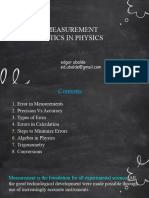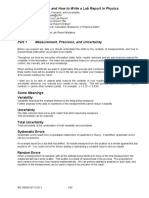Error and Uncertainty Notes
Uploaded by
Syazwani HussainError and Uncertainty Notes
Uploaded by
Syazwani HussainERROR & UNCERTAINTY NOTES: Error exists in all experiments due to limitations of equipment and the person performing
the work. No measurement is ever exact. The last digit of a measurement is always an estimate therefore it is an uncertain value. To allow for this in experiments we represent data including the error involved and in calculations we use significant digits. Accuracy vs. Precision: Draw a representation of the relationship between accurate and precise results.
Accuracy: a measure of how close a result is to an accepted, literature value for that experiment. Measurement of Accuracy: Percent Deviation (% Error):
Precision: The measure of the certainty of a result value, usually quoted as a . In general, the more significant figures a value has, the more precise the measurement. Practice:Assume the CORRECT width of a room is 5.32000 m. 1. A measurement of 5.3 m is ________ but not ______________ 2. Several measurements with some device consistently give the width as 5.45217 m, measurements are _______ but not ______ 3. A measurement is consistently 5.32001 m: it is ______ and ______. 4. If a measurement is 7.2 m, it is _____________ and _____________ .
Random or Systematic Error? Random Makes a measurement less precise, but not in a particular direction. Affected by how precisely you can read an instrument, shown by the error representation . Repeating a reading helps lower this error Systematic Always affect a result in a particular direction and therefore affect the accuracy of equipment. Sometimes used to explain inaccurate results Practice Examples: Classify the type of error: 1. Always reading a burette when it is above eye level 2. Reading a burette to 43.6 0.05 3. Improper reading of a liquid volume at the top of the meniscus. 4. Weighing a mass of a compound before transfer to another apparatus only. 5. A steady reading a digital scale to 37.361 0.0005 Absolute Uncertainty vs. Percentage Uncertainty Absolute: Actual uncertainty in the measurement (the value) Eg. 28.5 0.05 Percentage: The absolute represented as a percentage of the measured value. Eg. [(0.05)/28] x 100 = 0.18% 28.5 0.18% Calculating With Uncertainty ADDING & SUBTRACTING: Add ABSOLUTE uncertainties MULTIPLYING & DIVIDING: Add PERCENTAGE uncertainties then convert back to absolute uncertainty to represent your answer. This applies to exponents too as they mean multiply!
You might also like
- PHY 112_Measurement in Physics_errors_L3_2023No ratings yetPHY 112_Measurement in Physics_errors_L3_202338 pages
- IB Chem Topic 11 Errors and Uncertainties in MeasurementsNo ratings yetIB Chem Topic 11 Errors and Uncertainties in Measurements4 pages
- Chapter 1. Review Topics in Analytical ChemistryNo ratings yetChapter 1. Review Topics in Analytical Chemistry29 pages
- Q1 PHYSICS (Whor - Ney-Quiñones, Razzel S.)No ratings yetQ1 PHYSICS (Whor - Ney-Quiñones, Razzel S.)11 pages
- Accuracy Precision Forms of Errors NOTES 110038No ratings yetAccuracy Precision Forms of Errors NOTES 11003825 pages
- Errors in Measurement Mathematics in PhysicsNo ratings yetErrors in Measurement Mathematics in Physics21 pages
- Errors and Uncertainty in Experimental DataNo ratings yetErrors and Uncertainty in Experimental Data12 pages
- Introduction To Experimental Programme SL HLNo ratings yetIntroduction To Experimental Programme SL HL40 pages
- Measurement and Data Processing: I. Uncertainties and Errors in Measurement and ResultsNo ratings yetMeasurement and Data Processing: I. Uncertainties and Errors in Measurement and Results6 pages
- 2 Galata Measurement Error Significant Figures2023 2024 2No ratings yet2 Galata Measurement Error Significant Figures2023 2024 237 pages
- 2016 Lab Descriptions and Guides For PHYS 1114 and 2206No ratings yet2016 Lab Descriptions and Guides For PHYS 1114 and 220645 pages
- Chapter 1 - 1.2 Measurement - Conversion of UnitsNo ratings yetChapter 1 - 1.2 Measurement - Conversion of Units38 pages
- Tugas 1 Bahasa Inggris: Uncertainty in Measurements and CalculationNo ratings yetTugas 1 Bahasa Inggris: Uncertainty in Measurements and Calculation5 pages
- Multi-dimensional Monte Carlo Integrations Utilizing MathematicaFrom EverandMulti-dimensional Monte Carlo Integrations Utilizing MathematicaNo ratings yet
- Overview Of Bayesian Approach To Statistical Methods: SoftwareFrom EverandOverview Of Bayesian Approach To Statistical Methods: SoftwareNo ratings yet



























































